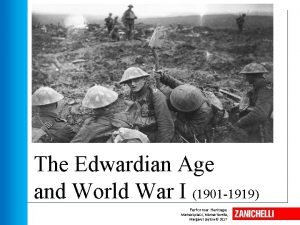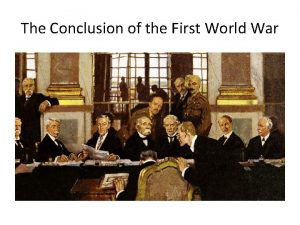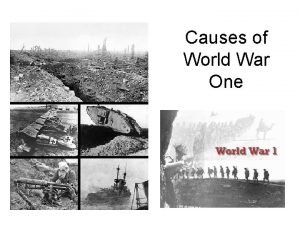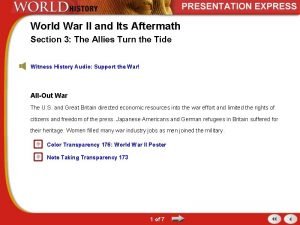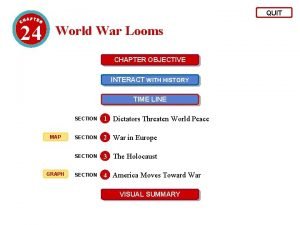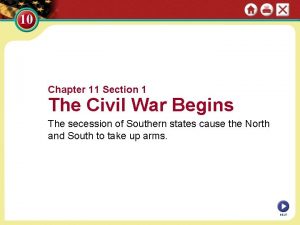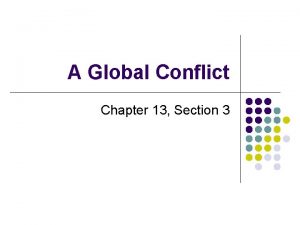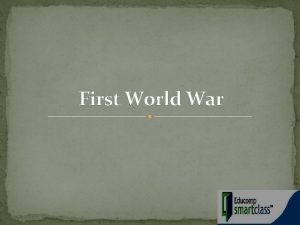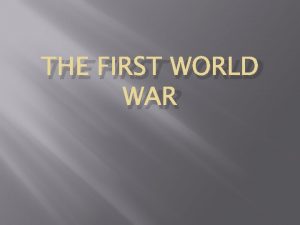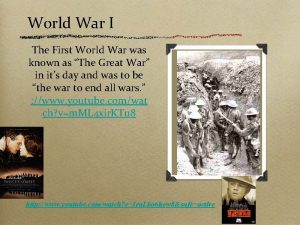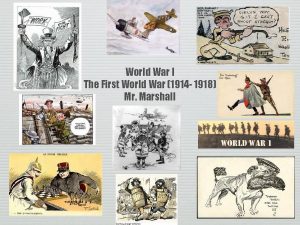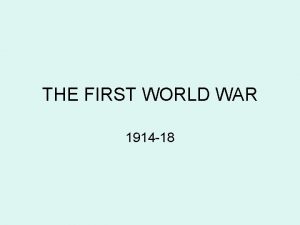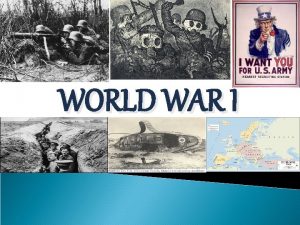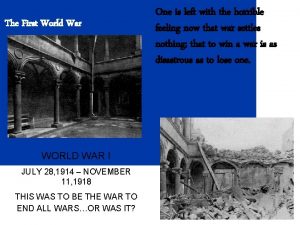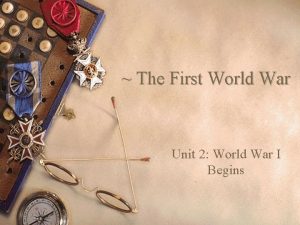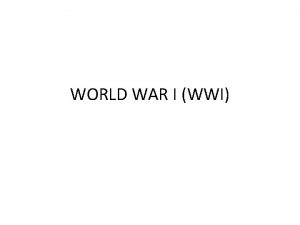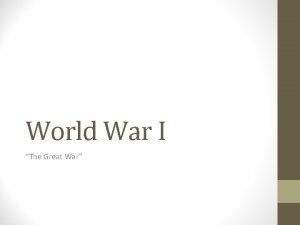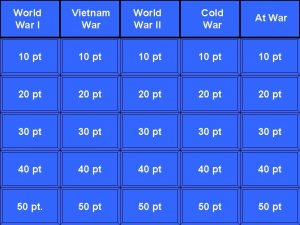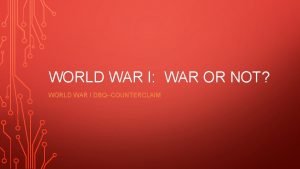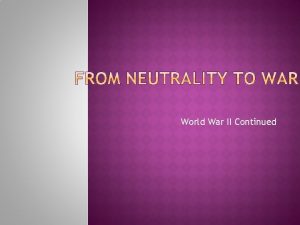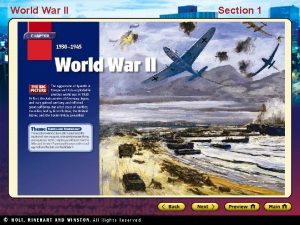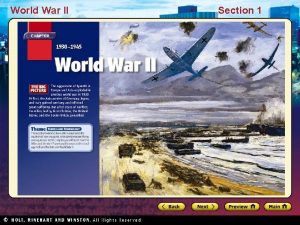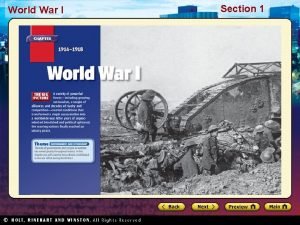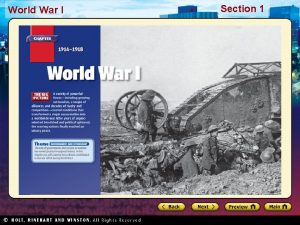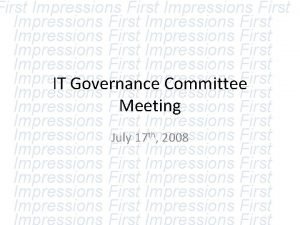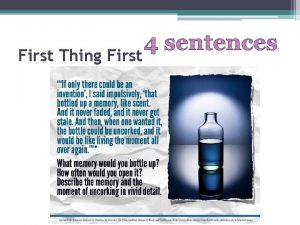The First World War SECTION 1 World War
































- Slides: 32

The First World War SECTION 1 World War I Begins SECTION 2 American Power Tips the Balance SECTION 3 The War at Home SECTION 4 Wilson Fights for Peace NEXT

Section 1 World War I Begins. NEXT

SECTION 1 World War I Begins I. Causes of World War I A. Nationalism 1. Nationalism—devotion to interests, culture of one’s nation 2. Nationalism leads to competition, antagonism between nations B. Imperialism 1. Germany industrializes, competes with France, Britain for colonies Continued. . . NEXT

SECTION 1 continued Causes of World War I C. Militarism 1. Cost of building, defending empires leads to more military spending 2. Militarism—development of armed forces, their use in diplomacy D. Alliance System • Triple Entente or Allies—France, Britain, Russia • Germany, Austria-Hungary, Ottoman Empire are Central Powers or Triple Alliance NEXT

SECTION 1 II. An Assassination Leads to War A. Alliances Complicate Conflict 1. Archduke Franz Ferdinand of Austria shot by Serbian nationalist 2. Austria-Hungary declares war on Serbia, expects short war 3. Alliance system pulls one nation after another into war NEXT

SECTION 1 III. The Fighting Starts A. Early Battles 1. Germany’s Schlieffen Plan: defeat France, then Russia 2. German troops sweep through Belgium 3. “No man’s land”—barren expanse between opposing trenches 4. Scale of killing horrific, fighting inconclusive 5. Armies fight to gain only yards of ground in bloody trench warfare NEXT

SECTION 1 IV. Americans Question Neutrality A. Divided Loyalties 1. Socialists, pacifists, many ordinary people against U. S. in war 2. Naturalized citizens concerned about effect on country of birth 3. Many feel ties to British ancestry, language, democracy, legal system 4. U. S. has stronger economic ties with Allies than with Central Powers NEXT

SECTION 1 V. The War Hits Home A. The U. S. Prepares 1. By 1917, U. S. has mobilized for war against Central Powers to: - ensure Allied repayment of debts - prevent Germans threat to U. S. shipping B. The British Blockade 1. British blockade, stop war supplies reaching Germany 2. Germany has difficulty importing food, fertilizer; by 1917, famine Continued. . . NEXT

SECTION 1 continued The War Hits Home C. German U-Boat Response 1. U-boat sinks British liner Lusitania; 128 Americans among the dead - U. S. public opinion turns against Germany 2. President Wilson protests, but Germany continues to sink ships The 1916 Election 1. Democrat Wilson defeats Republican Charles Evans Hughes NEXT

SECTION 1 VI. The United States Declares War A. German Provocation 1. Zimmerman note—proposes alliance of Germany, Mexico against U. S. 2. Four unarmed American merchant ships sunk 3. Russian monarchy replaced with representative government - war of democracies against monarchies B. America Acts 1. Wilson calls for war to make world “safe for democracy” NEXT

Section 2 American Power Tips the Balance NEXT

SECTION 2 American Power Tips the Balance I. America Mobilizes A. Raising an Army 1. Selective Service Act—men register, randomly chosen for service 2. African Americans in segregated units, excluded from navy, marines 3. Soldiers train for 8 months, often drill with fake weapons 4. Women in army, navy, marines as nurses secretaries, phone operators B. Mass Production 1. US expands fleet to transport men, food, equipment to Europe NEXT

SECTION 2 II. America Turns the Tide A. U. S. Navy Contributions 1. Convoy system—destroyers escort merchant ships across Atlantic - losses drop dramatically B. Fighting in Europe 1. After 2 1/2 years fighting, Allied forces are exhausted, demoralized 2. American troops bring numbers, freshness, enthusiasm NEXT

SECTION 2 III. Fighting “Over There” A. Doughboys in Europe • General John J. Pershing leads American Expeditionary Force - soldiers impressed by cities, shocked by battle B. New Weapons 1. By 1917, British learn to use tanks to clear path for infantry 2. Early planes flimsy, only do scouting; later ones stronger, faster - carry machine guns, heavy bomb loads NEXT

SECTION 2 IV. The War Introduces New Hazards A. New Problems of War 1. New weapons and tactics lead to horrific injuries, hazards 2. Troops amidst filth, pests, polluted water, poison gas, dead bodies 3. Constant bombardment, battle fatigue produce “shell shock” 4. Physical problems include dysentery, trench foot, NEXT

SECTION 2 V. American Troops Go on the Offensive A. Allies Stop German Advance 1. Russia pulls out of war 1917; Germans shift armies to western front - come within 50 miles of Paris 2. Americans help stop German advance, turn tide against Central Powers Continued. . . NEXT

SECTION 2 continued American Troops Go on the Offensive B. The Collapse of Germany 1. German kaiser gives up throne 2. Germans exhausted; armistice, or truce, signed November 11, 1918 C. The Final Toll 1. World War I bloodiest war in history to date a. more than half of 22 million dead are civilians b. 20 million more are wounded 2. 10 million people become refugees NEXT

Section 3 The War at Home. NEXT

SECTION 3 The War at Home I. Congress Gives Power to Wilson A. War Industries Board 1. Economy shifts from producing consumer goods to war supplies 2. Congress gives president direct control of much of the economy 3. War Industries Board is main regulatory body - urges mass-production, standardizing products 4. Bernard M. Baruch, prosperous businessman, is head of board Continued. . . NEXT

SECTION 3 continued Congress Gives Power to Wilson B. War Economy 1. Industrial wages rise; offset by rising costs of food, housing 2. Large corporations make enormous profits 3. Unions boom from dangerous conditions, child labor, unfair pay 4. Wilson creates National War Labor Board to settle disputes C. Food Administration 1. Food Administration under Herbert Hoover works to produce, save food 2. Encourages public conservation, increase of farm production NEXT

SECTION 3 II. Selling the War A. War Financing 1. 1/3 paid through taxes, 2/3 borrowed through sale of war bonds B. Committee on Public Information 1. Propaganda—biased communication designed to influence people 2. Former muckraker George Creel heads Committee on Public Information 3. Creel produces visual works, printed matter to promote war 4. Gets volunteers to speak about war, distribute materials NEXT

SECTION 3 III. Attacks on Civil Liberties Increase A. Anti-Immigrant Hysteria 1. Attacks against immigrants, especially from Germany, Austria-Hungary 2. Suppression of German culture—music, language, literature B. Espionage and Sedition Acts 1. Espionage and Sedition Acts—person can be fined, imprisoned for: - interfering with war effort, speaking against government 2. Violate 1 st amendment - target socialists, labor leaders NEXT

SECTION 3 IV. The War Encourages Social Change A. African Americans and the War 1. Du Bois urges support for war to strengthen call for racial justice 2. Most African Americans support war B. The Great Migration 1. Great Migration—large-scale movement of Southern blacks to North a. escape racial discrimination b. take up new job opportunities 2. Press of new migrants intensifies racial tensions in North Continued. . . NEXT

SECTION 3 continued The War Encourages Social Change C. Women in the War 1. Many women take jobs in heavy industry previously held by men 2. Many do volunteer work for war effort 3. Some active in peace movement; Women’s Peace Party founded 1915 4. Women’s effort bolsters support for suffrage; 19 th Amendment passes D. The Flu Pandemic 1. International flu epidemic of 1918 has devastating effect on economy 2. As many as 30 million people die worldwide NEXT

Section 4 Wilson Fights for Peace NEXT

SECTION 4 Wilson Fights for Peace I. Wilson Presents His Plan A. Fourteen Points 1. Wilson’s plan for world peace known as Fourteen Points 2. Points 1– 5 propose measures to prevent another war 3. 6– 13 address how ethnic groups can form own nations or join others 4. 14 calls for international organization or League of Nations to enable nations to discuss, settle problems without war Continued. . . NEXT

SECTION 4 continued Wilson Presents His Plan B. The Allies Reject Wilson’s Plan 1. Wilson fails to grasp anger of Allied leaders against Germany 2. French premier Georges Clemenceau wants to prevent German invasion 3. British Prime Minister David Lloyd George wants to “Make Germany Pay” 4. Italian Vittorio Orlando wants Austrian-held territory 5. Conference excludes Central Powers, Russia, small Allied nations 6. Wilson gives up most of his points in return for League of Nations NEXT

SECTION 4 II. Debating the Treaty of Versailles A. Provisions of the Treaty 1. Treaty of Versailles creates 9 new nations 2. Places various conditions on Germany: a. cannot have an army b. pay reparations, or war damages Continued. . . NEXT

SECTION 4 continued Debating the Treaty of Versailles B. The Treaty’s Weaknesses 1. War-guilt clause—Germany must accept sole responsibility for war 2. Germany cannot pay reparations that Allies want 3. Russia loses more land than Germany 4. Colonized people’s claims for self-determination ignored Continued. . . NEXT

SECTION 4 continued Debating the Treaty of Versailles C. Opposition to the Treaty 1. Strong opposition to treaty in U. S. 2. Some, like Hoover, think treaty too harsh, fear economic effects D. Debate over the League of Nations 1. Some think League threatens U. S. foreign policy of isolation 2. Senators like Henry Cabot Lodge mistrust provision for joint action Continued. . . NEXT

SECTION 4 continued Debating the Treaty of Versailles E. Wilson Refuses to Compromise 1. Goes on speaking tour to convince nation to support League - has stroke, is disabled 2. November 1919, Lodge introduces amendments to treaty 3. Wilson refuses to compromise 4. March 1920, neither amendments nor treaty approved 5. U. S. , Germany sign separate treaty; U. S. never joins League NEXT

SECTION 4 III. The Legacy of the War A. Consequences of the War 1. In U. S. , war strengthens military, increases power of government 2. Accelerates social change for African Americans, women 3. Fears, antagonisms provoked by propaganda remain 4. In Europe, destruction, loss of life damage social, political systems - Communist, fascist governments form 5. Treaty of Versailles does not settle conflicts in Europe NEXT
 Why was the civil war the first modern war
Why was the civil war the first modern war The edwardian age and world war i zanichelli
The edwardian age and world war i zanichelli First world war conclusion
First world war conclusion Caused of ww1
Caused of ww1 World war 2 and its aftermath section 3 quiz
World war 2 and its aftermath section 3 quiz Chapter 24 world war looms section 1 answers
Chapter 24 world war looms section 1 answers Chapter 24 world war looms section 1 answers
Chapter 24 world war looms section 1 answers Chapter 11 section 1 the civil war begins answer key
Chapter 11 section 1 the civil war begins answer key World war 1 begins chapter 11 section 1
World war 1 begins chapter 11 section 1 Chapter 13 section 3 a global conflict
Chapter 13 section 3 a global conflict World war 1 begins chapter 19 section 1
World war 1 begins chapter 19 section 1 Hình ảnh bộ gõ cơ thể búng tay
Hình ảnh bộ gõ cơ thể búng tay Frameset trong html5
Frameset trong html5 Bổ thể
Bổ thể Tỉ lệ cơ thể trẻ em
Tỉ lệ cơ thể trẻ em Gấu đi như thế nào
Gấu đi như thế nào Tư thế worms-breton
Tư thế worms-breton Hát lên người ơi alleluia
Hát lên người ơi alleluia Các môn thể thao bắt đầu bằng từ đua
Các môn thể thao bắt đầu bằng từ đua Thế nào là hệ số cao nhất
Thế nào là hệ số cao nhất Các châu lục và đại dương trên thế giới
Các châu lục và đại dương trên thế giới Công thức tính thế năng
Công thức tính thế năng Trời xanh đây là của chúng ta thể thơ
Trời xanh đây là của chúng ta thể thơ Cách giải mật thư tọa độ
Cách giải mật thư tọa độ Làm thế nào để 102-1=99
Làm thế nào để 102-1=99 Phản ứng thế ankan
Phản ứng thế ankan Các châu lục và đại dương trên thế giới
Các châu lục và đại dương trên thế giới Thơ thất ngôn tứ tuyệt đường luật
Thơ thất ngôn tứ tuyệt đường luật Quá trình desamine hóa có thể tạo ra
Quá trình desamine hóa có thể tạo ra Một số thể thơ truyền thống
Một số thể thơ truyền thống Cái miệng nó xinh thế chỉ nói điều hay thôi
Cái miệng nó xinh thế chỉ nói điều hay thôi Vẽ hình chiếu vuông góc của vật thể sau
Vẽ hình chiếu vuông góc của vật thể sau Thế nào là sự mỏi cơ
Thế nào là sự mỏi cơ

